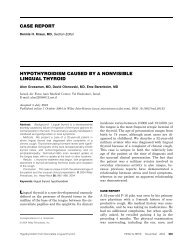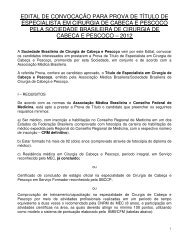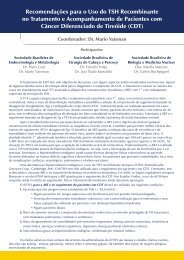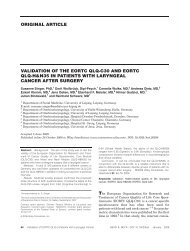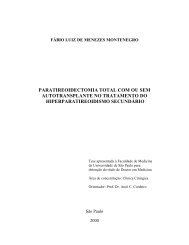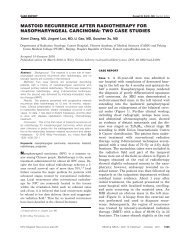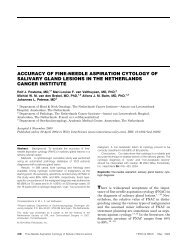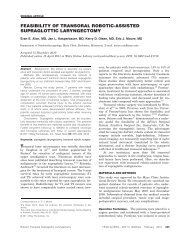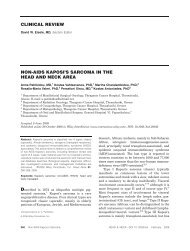FIGURE 3. Immunostaining for beta-catenin. The <strong>cribriform</strong>-<strong>morular</strong> <strong>variant</strong> in case 2 shows aberrant nuclear and cytoplasmic staininginside and outside the morule, which is delineated by arrows (left). The adjacent normal <strong>thyroid</strong> shows membranous staining only(right). [Color figure can be viewed in the online issue, which is available at www.interscience.wiley.com.]ing more aggressive <strong>variant</strong>s <strong>of</strong> <strong>thyroid</strong> <strong>carcinoma</strong>s,such as poorly differentiated <strong>thyroid</strong> <strong>carcinoma</strong>.The <strong>cribriform</strong>-<strong>morular</strong> <strong>variant</strong> <strong>of</strong>ten showspseudostratified nuclei, leading to an erroneous diagnosis<strong>of</strong> columnar cell <strong>carcinoma</strong>, a potentiallyaggressive <strong>variant</strong> <strong>of</strong> PTC. The reverse is alsotrue, in the sense that hyalinized areas, a frequentoccurrence in the <strong>cribriform</strong>-<strong>morular</strong> <strong>variant</strong>, canpoint toward a diagnosis <strong>of</strong> hyalinizing trabeculartumor, a neoplasm with excellent prognosis (evenbetter than the <strong>cribriform</strong>-<strong>morular</strong> <strong>variant</strong>) if strictlydefined.The diagnosis <strong>of</strong> <strong>thyroid</strong> cancer can predatethe symptoms <strong>of</strong> colorectal polyposis by 4 to 12years in up to 30% <strong>of</strong> patients in some series. 8,10In one study <strong>of</strong> seven patients with the <strong>cribriform</strong><strong>morular</strong><strong>variant</strong> <strong>of</strong> PTC, two patients were foundto have polyposis; both tested positively for germlineadenomatous polyposis coli (APC) gene mutation,and both underwent subsequent colectomy. 2Because <strong>of</strong> the potential <strong>of</strong> detecting FAP early inpatients diagnosed with the <strong>cribriform</strong>-<strong>morular</strong><strong>variant</strong>, we strongly encouraged our first patientto undergo screening colonoscopy. Fortunately,colonoscopy ruled out the presence <strong>of</strong> colonicpolyposis. If screening can detect FAP, it is possibleto reduce the development <strong>of</strong> an individual’srisk <strong>of</strong> colorectal cancer.Immunohistochemically, these tumors stainpositively for estrogen and progesterone receptorsthat may correlate with the female predominancein the <strong>cribriform</strong>-<strong>morular</strong> <strong>variant</strong>. The tumorsalso stain well for thyroglobulin, cytokeratins AE1/AE3 and cytokeratin 7, and have also been shownto stain positively for cytokeratin 34betaE12,neuron-specific enolase, vimentin, bcl-2, and retinoblastomaprotein. 1,4,11 The tumor in our patientwith FAP stained for thyroglobulin and cytokeratin7 and was negative for cytokeratin 20, indicatingits lineage from the <strong>thyroid</strong> follicular epithelium.In PTC associated with FAP, genetic alterationsinclude germline APC mutations, 12 somaticmutations, 13 or loss <strong>of</strong> heterozygosity <strong>of</strong> the APCgene. 9,12,14 In addition to loss <strong>of</strong> function <strong>of</strong> theAPC gene, genetic alterations in FAP-associated<strong>thyroid</strong> cancer involve gain <strong>of</strong> function <strong>of</strong> the retproto-oncogene (ret/PTC). 15 In fact, two smallseries have shown a 80% to 100% frequency <strong>of</strong>ret/PTC rearrangement and activation <strong>of</strong> theret/PTC1 and ret/PTC3 is<strong>of</strong>orms in these patients. 7,15As seen in our first patient, the <strong>cribriform</strong><strong>morular</strong><strong>variant</strong> may be encountered in patientswith non-FAP. First described in 1999, the sporadic<strong>cribriform</strong>-<strong>morular</strong> <strong>variant</strong> <strong>of</strong> PTC tends tobe well circumscribed and solitary and also occursin women younger than 30. 16 Immunohistochemically,these tumors stain positively for thyroglobulin,as with our first patient, and for cytokeratins,vimentin, estrogen, and progesterone receptors,bcl2, and retinoblastoma protein. 16 In onestudy <strong>of</strong> seven patients diagnosed with the <strong>cribriform</strong>-<strong>morular</strong><strong>variant</strong>, four patients had no evidence<strong>of</strong> polyposis or APC gene mutation. 2 However,a somatic APC mutation was found in a474 Cribriform-Morular Variant <strong>of</strong> Papillary Cancer HEAD & NECK—DOI 10.1002/hed May 2006
patient without a germline APC mutation. 17 Thesepatients with the sporadic <strong>cribriform</strong>-<strong>morular</strong> <strong>variant</strong>have an excellent prognosis, with one reportdescribing no recurrence <strong>of</strong> tumor up to 13 yearsafter diagnosis. 16Mutant beta-catenin contributes to the development<strong>of</strong> the <strong>cribriform</strong>-<strong>morular</strong> <strong>variant</strong> <strong>of</strong> PTCin both FAP and sporadic forms. 11 APC forms amacromolecular complex with beta-catenin and isinvolved in the Wnt transduction signaling pathway,sequestering beta-catenin and targeting itfor degradation. 18,19 Mutations in the APC genelead to a truncated APC protein that lacks theability to degrade beta-catenin, leading to increasedcytoplasmic beta-catenin levels. 20 Cytoplasmicand nuclear immunolocalization <strong>of</strong> beta-cateninin FAP-associated <strong>cribriform</strong>-<strong>morular</strong> <strong>variant</strong> <strong>of</strong>PTC suggests an abnormality in the Wnt transductionsignaling pathway. 21 Xu et al 11 demonstratedsomatic mutations in the beta-catenin geneCTNNB1 in patients with either FAP-associatedor sporadic <strong>cribriform</strong>-<strong>morular</strong> <strong>variant</strong> <strong>of</strong> PTC.Cytoplasmic and nuclear immunolocalization <strong>of</strong>beta-catenin was noted in both sets <strong>of</strong> patients,suggesting that the aberrant nuclear accumulation<strong>of</strong> mutant beta-catenin can occur independentlyfrom APC mutations and may contribute tothe genesis <strong>of</strong> these tumors. 11 Beta-catenin alsoseems to be responsible for the peculiar morphology(i.e., <strong>cribriform</strong> growth and morules) seen inthese tumors. Indeed, beta-catenin accumulationhas also been found in ex-tra<strong>thyroid</strong>al neoplasmsdisplaying morules and intricate glandular growthpatterns, such as fetal lung adeno<strong>carcinoma</strong> andendometrioid-type adeno<strong>carcinoma</strong> <strong>of</strong> the endometrium.22Also, supporting a role in the morphogenesis <strong>of</strong>the <strong>cribriform</strong>-<strong>morular</strong> <strong>variant</strong> is the fact thatbeta-catenin nuclear/cytoplasmic accumulationis critical in the epithelial budding, branching,and hair follicle formation in embryogenesis. The<strong>cribriform</strong> pattern may, therefore, recapitulatethe epithelial budding seen in embryos, and themorules may recapitulate the hair formation seenin embryogenesis. 22In our patient with FAP, we found aberrantaccumulation <strong>of</strong> beta-catenin in the tumor nuclei,in agreement with previous reports. However,the tumor in our sporadic case did not show betacateninnuclear or cytoplasmic staining, and therewas no estrogen or progesterone immunoreactivity.These findings suggest alternative pathways(other than beta-catenin) may be responsible forthe formation <strong>of</strong> these neoplasms.Because <strong>of</strong> their multicentricity and bilaterality,total <strong>thyroid</strong>ectomy is the treatment <strong>of</strong> choice forthe <strong>cribriform</strong>-<strong>morular</strong> <strong>variant</strong> <strong>of</strong> PTC. 1 Althoughthe tumor in our patient with non-FAP did notreveal multicentricity, the tumor <strong>of</strong> the patientwith FAP did demonstrate multicentricity, supportingthe argument for total <strong>thyroid</strong>ectomy inthese patients. These tumors may metastasize toregional lymph nodes. Long-term prognosis isexcellent for patients with FAP-associated <strong>cribriform</strong>-<strong>morular</strong><strong>variant</strong>, with 5-year and 20-yearsurvival rates <strong>of</strong> 90% and 77%, respectively. 1CONCLUSIONSThe <strong>cribriform</strong>-<strong>morular</strong> <strong>variant</strong> <strong>of</strong> <strong>papillary</strong> <strong>thyroid</strong>cancer may be associated with familial adenomatouspolyposis. Patients with FAP in whomthere is a concern for PTC should undergo total<strong>thyroid</strong>ectomy. Although rare, when the <strong>cribriform</strong>-<strong>morular</strong><strong>variant</strong> is diagnosed, patients shouldundergo screening colonoscopy to rule out thepresence <strong>of</strong> colonic polyposis. The prognosis <strong>of</strong> this<strong>variant</strong> <strong>of</strong> PTC is similar to that <strong>of</strong> the classicaltype. This distinct histologic finding should alertphysicians to screen such patients and their familymembers for FAP, thereby facilitating early diagnosis<strong>of</strong> FAP.REFERENCES1. Perrier ND, van Heerden JA, Goellner JR, et al. Thyroidcancer in patients with familial adenomatous polyposis.World J Surg 1998;22:738–742.2. Tomoda C, Miyauchi A, Uruno T, et al. Cribriform-<strong>morular</strong><strong>variant</strong> <strong>of</strong> <strong>papillary</strong> <strong>thyroid</strong> <strong>carcinoma</strong>: clue to earlydetection <strong>of</strong> familial adenomatous polyposis-associatedcolon cancer. World J Surg 2004;28:886–839.3. Harach HR, Williams GT, Williams ED. Familial adenomatouspolyposis associated <strong>thyroid</strong> <strong>carcinoma</strong>: a distincttype <strong>of</strong> follicular cell neoplasm. Histopathology 1994;25:549–561.4. Ng SB, Sittampalam K, Goh YH, Eu KW. Cribriform<strong>morular</strong><strong>variant</strong> <strong>of</strong> <strong>papillary</strong> <strong>carcinoma</strong>: the sporadic counterpart<strong>of</strong> familial adenomatous polyposis-associated <strong>thyroid</strong><strong>carcinoma</strong>. A case report with clinical and moleculargenetic correlation. Pathology 2003;35:42–46.5. Clark SK, Phillips RK. Desmoids in familial adenomatouspolyposis. Br J Surg 1996;83:1494–1504.6. Camiel MR, Mule JE, Alexander LL, Benningh<strong>of</strong>f DL.Association <strong>of</strong> <strong>thyroid</strong> <strong>carcinoma</strong> with Gardner’s syndromein siblings. N Engl J Med 1968;278:1056–1058.7. Cetta F, Chiappetta G, Melillo RM, et al. The ret/ptc1oncogene is activated in familial adenomatous polyposisassociated<strong>thyroid</strong> <strong>papillary</strong> <strong>carcinoma</strong>s. J Clin EndocrinolMetab 1998;83:1003–1006.8. Cetta F, Pelizzo MR, Curia MC, Barbarisi A. Geneticsand clinicopathological findings in <strong>thyroid</strong> <strong>carcinoma</strong>s associatedwith familial adenomatous polyposis. Am J Pathol1999;155:7–9.Cribriform-Morular Variant <strong>of</strong> Papillary Cancer HEAD & NECK—DOI 10.1002/hed May 2006 475



